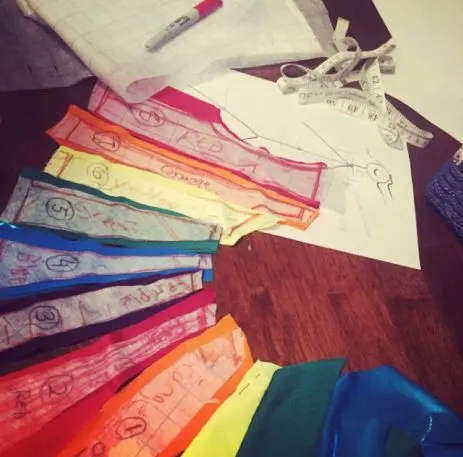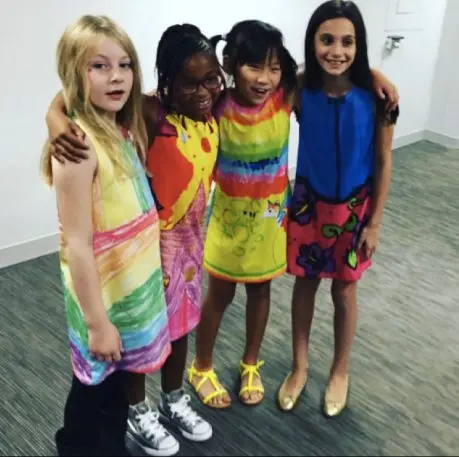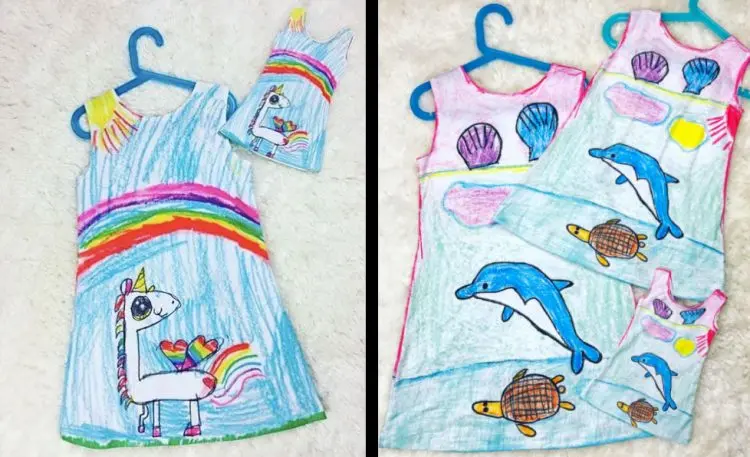Jaimee Newberry, a user-experience expert and creative coach and speaker who lives in Las Vegas, likes to say “yes” more than “no.” When her young daughter Zia asked if she could turn a dress she’d drawn into reality, Newberry, by her nature, agreed.
She spent about $100 on fabric and supplies to create a rainbow dress that Zia wore everywhere. When Zia was asked—frequently—about the dress, she would reply, “You can’t get it in a store. We made it! It came from my imagination. It was my idea.”

Like many manufacturing ideas now blooming in America, the concept is simple and the execution complicated, and relies on software to add value and improve efficiency within a set of physical processes. “Software is eating the world,” Marc Andreessen said, referring to software’s ability to replace tasks that required mechanical or hard-wired electronic processes.
In this case, however, software is eating soft wear: Picture This Clothing is feasible only because of custom, in-house code that converts kids’ color drawings into something that, at the end of the production process, matches that original vision.

Printing A Unicorn
Newberry wasn’t looking for a new business. This one found her. She had a full-time job at Swingset and was shifting into the chief operating officer role at MartianCraft, an app engineering and consulting firm. Her boyfriend, Ken Finney, however, thought that was a germ of something. Newberry recalls her reaction. “I’m not making custom clothes for children!”
Newberry and Finney—both veterans of Zappos who worked on the ecommerce brand’s first mobile app—spent months talking about the idea. “We ran numbers, and it would require outsourcing overseas, paying probably children in factories to work for pennies a day to re-create these designs and not charge our customers $300 an item. It just didn’t seem realistic to us, or like something we really wanted to pursue in that way,” Newberry says.
Newbury says the turning point came when Finney suggested that kids wore their drawing quite literally, instead of having a dress assembled. This led them to dye-sublimation printing, a way to take a digital image and produce full-color output that can be transferred to many forms of media, including fabric. (Buttonsmith, which Fast Company wrote about in September, uses dye sublimation for its custom lanyard printing.)

A customer prints out the dress template, designed for a standard 8 1/2-by-11 sheet. After the drawing is done, the company strongly advises taking a smartphone snapshot rather than scanning, which with average users tends to result in a blown-out image. You even have to check a box labeled “I pinky swear I’m not uploading a scan. I took this picture with my phone.” Once a customer uploads the image, Picture This Company’s secret sauce—Finney’s programming—fixes the proportions, colors, and other optical errors.
Getting the color right is critical. Newberry, who has two daughters, says, “A lot of parents maybe don’t realize the importance of this, but to a kid, the color matching and the little things not getting cut off on the sleeve—those details are really important.” The design prints identically front and back.
With these systems in place, Newberry launched the company in August 2016, with no real expectations. But the announcement video—and the company’s brightly colored vision of converting imagination into reality—quickly went viral; that first day, the company made $10,000 in sales. Even with a roughly 60-day turnaround time and a Thanksgiving cutoff for Christmas delivery, volume remained high through December.
The company’s volume isn’t high enough to push hard for a faster or consistent turnaround—it currently operates with a handful of employees—but as their operations increase, they’ll be working on getting clothing to customers sooner. Currently, the site offers a 30-day delivery target, but Newberry says they generally hit 10 days.
A personalized dress isn’t cheap: it’s $49 a pop plus modest U.S. shipping and somewhat more expensive international dispatch costs. But it’s unique, and—if one can draw inferences from one-off product sites like Cafe Press and giants like Etsy and Kickstarter—consumers are seeking greater individual expression in an age of mass production of hip and trendy ideas.

Still, controlling the company’s narrative has presented its own challenge for Newberry. Amid the press attention after launch, she says, TV producers and others tried to cast hers as a “what a cute stay-at-home mom” startup, an impression she tried to correct, for instance, when she appeared on the Harry Connick, Jr., Show. While she is a single mom, and two of her employees are the same, Newberry’s also occupied director and C-level positions across her career. “I prefer the term independent mom for myself,” she says.
The responsibility of running her own business hasn’t led her to be risk adverse, she says, but she thinks hard about the consequences of her actions up and down the line. “The folks who cut and sew are a small team, but nonetheless everybody needs to make a living,” she says. The product is labor intensive, and they’re working on ways to make it less so as they expand, part of the necessity in scaling and gaining increased control of costs.
With copycats lurking—including some who, Newberry showed me, copied photos of her products, and even her daughter, from the Picture This site—she’s playing her cards close to her vest. So far, the firm hasn’t taken outside investment, but it sees a high return rate of customers even within the first year and change. She expects some might make it a Christmas tradition, and the addition of adult sizes and tees help with that.
“We’re a family of idea makers,” says Newberry, clearly excited about a generation of kids whom she sees as more interested in making than consuming. “Teaching kids that is the most important value that we could try to amplify through this company.”
Recognize your brand’s excellence by applying to this year’s Brands That Matter Awards before the early-rate deadline, May 3.
